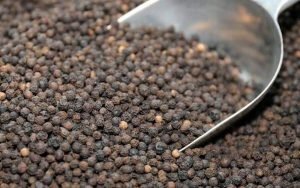
Is red pepper the same as black pepper?
Red, white, green and black peppers all come from the same species, it’s just that they are at different stages of ripening.
To begin with, a golden rule: if your pepper doesn’t sting or taste spicy when you eat it, then throw it in the bin! Often this means that it has been ground for more than three months, or it is cheap, made of expired berries, or has not developed properly.
To be sure of its origin and to be sure of getting all the benefits, the best thing to do is to grind your pepper yourself.
A good quality pepper should be round, compact and have a strong taste.
3 tips to judge its quality:
- It should not crumble under your fingers;
- it should tickle your nostrils when you smell it;
- it should leave a greasy trace when you crush it on a sheet of paper (yes, depending on its origin, pepper contains between 3 and 7 grams of lipids per 100 grams!)
Piperine is the molecule that gives pepper it’s spiciness. Light causes the piperine to break down and dissipate its flavour, so always store your pepper away from light or in a dark container.
Is pepper good for you?
Pepper is so much more than a condiment. It contains many minerals, trace elements and vitamins (potassium, calcium, magnesium, iron, zinc, copper, vitamins E, A, B, K etc.).
Piper nigrum is a berry from a tropical vine of the piperaceae family.
Its name comes from the Sanskrit pippali, which in Greek became peperi, in Latin piper, then peivere in old French.
Like many spices, it has long served as a valuable currency. In everyday life, it was mainly used to preserve food or to purify water.
Traditionally, it has been used in Chinese medicine and Ayurveda. In Chinese medicine, it is considered a pungent and calorific food, useful for regulating the digestive system.
Its function is to :
- warming the stomach,
- harmonise the diaphragm,
- to bring down energy, dissolve mucus,
- eliminate toxins from meat, fish and mushrooms,
- soothe pain caused by cold,
- eliminate fluid retention,
- stimulate appetite and digestion.
Ayurveda is no exception: pepper is one of the most widely used stimulants of the digestive glands in this medicine.
It is used in many formulas because it provides a penetrating power to the plants with which it is associated. It increases agni, the digestive fire, and burns the accumulation of toxins (ama).
It is also believed to have expectorant, cleansing and analgesic properties. It relieves headaches and tones the nervous system.
Black pepper is one of the best Ayurvedic remedies to counteract mucus-forming foods. Starchy foods in particular create “glues” during digestion: they promote the production of mucus in the bronchi and ear nose and throat area, sometimes leading to associated pathologies.
The piperine (molecule) and terpenes (hydrocarbons) that give it its curative properties.
